- What is Social Selling Index on LinkedIn?
- Where to find your LinkedIn Social Selling Index?
- How to increase your LinkedIn SSI score fast? Best practices
- How to use LinkedIn Automation to improve your LinkedIn SSI score?
- Case study: How to move from the top 41% to the top 2% of the LinkedIn SSI ranking in your industry?
- Conclusion: Impact of the LinkedIn Social Selling Index score
- Frequently Asked Questions (FAQ)
For over 10 years, LinkedIn has been providing all its users with a unique indicator free of charge: the LinkedIn Social Selling Index, or LinkedIn SSI score. 👀
Some monitor it daily, others don’t even know it exists, and many still wonder what it’s really for or how to improve it…
This score out of 100 measures your ability to use LinkedIn as a real sales and relationship tool. 💯 For a long time, this score was considered a gimmick… until LinkedIn published an unequivocal figure:
“Users with a high LinkedIn SSI score generate 45% more sales opportunities than those with a low LinkedIn score.”
✨ In this comprehensive guide, you will discover:
- What LinkedIn SSI score really is, what it’s used for, and how it’s calculated.
- Where and how to find your score in seconds.
- How to improve each of the four pillars of social selling with concrete, simple, and measurable actions.
- How to automate certain actions to boost your performance?
- Case study: how to go from the top 41% to the top 2% in your sector in just a few months?
Let’s go. 🚀
What is Social Selling Index on LinkedIn?
📊 The LinkedIn Social Selling Index isn’t just a nice KPI (key performance indicator): it’s a concrete indicator for measuring your effectiveness in using the platform for visibility, networking, prospecting, influence, etc.
How is LinkedIn SSI calculated? This is not an arbitrary score: LinkedIn analyzes your interactions, presence, content, and the quality of your network to generate a score between 1 and 100.
It does not measure your sales (LinkedIn does not have access to your CRM), but it evaluates everything that makes them possible in your e-reputation: visibility, credibility, engagement, and network quality. 💎
Here are the four pillars of the LinkedIn Social Selling Index score, each rated out of 25 points. Together, they form your overall score and reflect your ability to 👇🏼:
- Establish your personal brand.
- Find and target the right people on LinkedIn.
- Exchange information,
- Build strong professional relationships.
Reminder about the LinkedIn SSI index: you will be ranked based on your performance and that of others in your industry.
🤑 LinkedIn makes money from user engagement—the more you use the social network, the more it grows. By developing your SSI, you help LinkedIn thrive.
🤝 Your goal: to be better than others and boost your conversion rate through the network.
In other words, the higher your SSI, the more LinkedIn understands that you are a serious, active, relevant user… and the more it promotes you, and therefore the more results you will get. 🤩
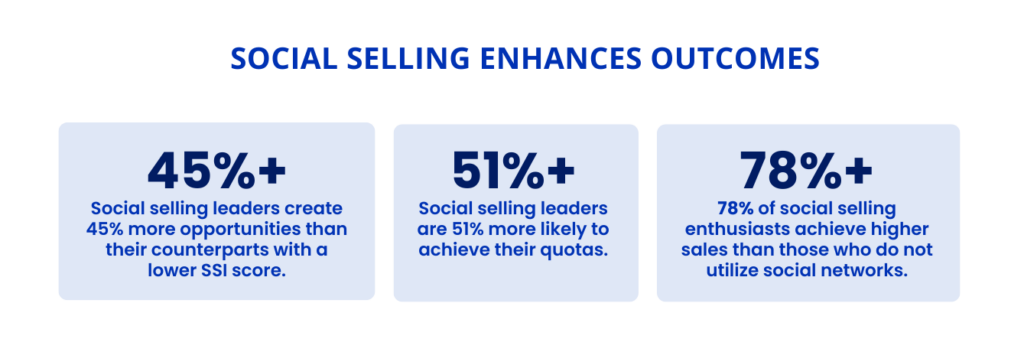
What is the point of the LinkedIn Social Selling Index?
LinkedIn SSI score is not a “vanity metric.” It actually influences your performance on the platform.
Why? 🤔 Because the four pillars of SSI describe precisely what the LinkedIn algorithm favors:
- An optimized profile → better visibility, better credibility.
- Consistent interactions → better connection recommendations.
- A targeted network → more frequent appearances in your ICP’s feed.
- Engagement → natural amplification of reach on high value-added information.
- Maintained relationships → conversations, exchanges, deals.
The LinkedIn Social Selling score measures how well your LinkedIn presence can engage an audience and become a driver for lead acquisition/generation. 🫂
When your score goes up, you will generally see 🔥:
- More views on your posts,
- More profile visits,
- More connection requests,
- No more replies to your messages,
- More appointments or incoming opportunities.
It’s not magic: it’s simply the translation of effective behaviors on LinkedIn to convince your audience and prospects that you are an authority (even before they come into direct contact with you)! 👌🏻
Where to find your LinkedIn Social Selling Index?
Where can you find your LinkedIn SSI score? The good news is that it’s available to everyone, free of charge, even without LinkedIn Sales Navigator. 😊
👉 Direct link to view your LinkedIn Social Selling Index calculator (free tool): https://www.linkedin.com/sales/ssi

Once on the page, click on “Get my social selling index for free.” You will then see in your SSI dashboard 🧮:
- Your overall/average SSI score,
- The score for each of the four pillars (LinkedIn also provides a quick definition of each pillar, which we describe in more detail below).
- Your ranking in relation to your sector,
- Your ranking in relation to your network,
- The industry average and the average of your connections.
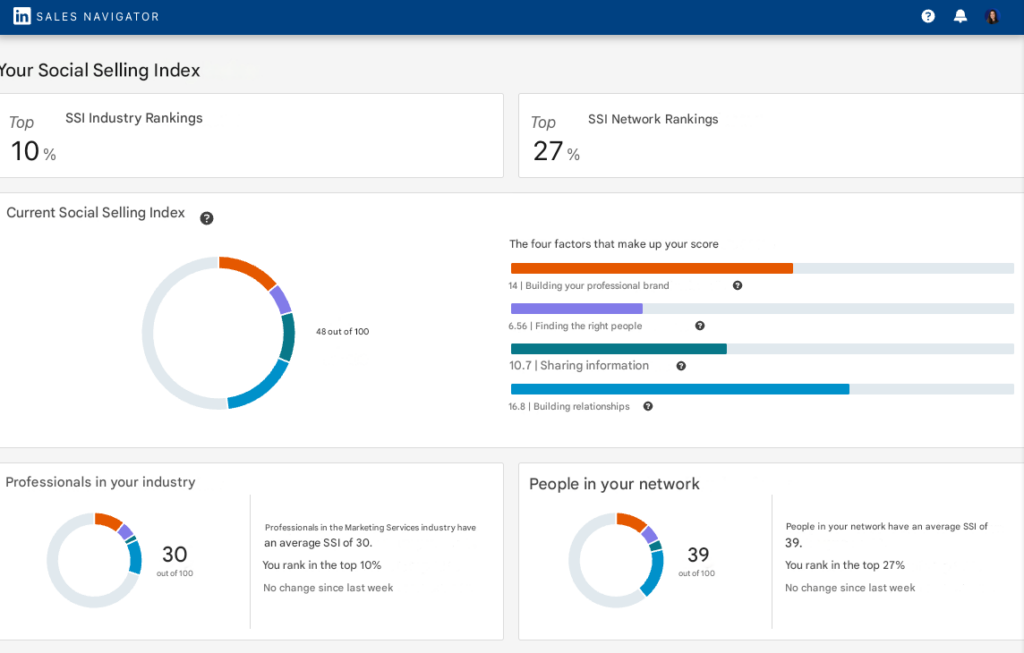
For each indicator/pillar, you can directly analyze the effectiveness of your social selling strategy. 👇🏼
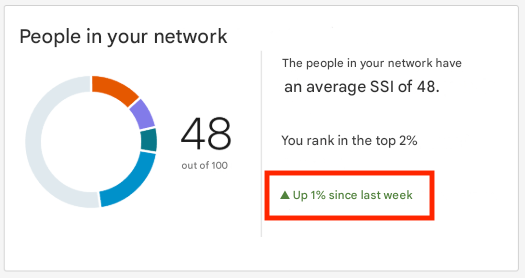
If you have a low score, or if other professionals in your industry have a better SSI score LinkedIn than you, who will be promoted more? Your competitors. They will therefore be more likely to generate higher professional performance than you.
This isn’t a competition. Just because your colleagues have 4 points more than you doesn’t mean they’ll make more sales. Rather, it’s an indicator of how you can improve.
How often is the LinkedIn SSI updated? The table is updated daily, but there’s no need to check your SSI score several times a day: weekly monitoring is more than enough. 🧘🏻♀️
How to increase your LinkedIn SSI score fast? Best practices
Now that you know your SSI, the next question is, how can you improve your LinkedIn Social Selling Index?
It’s simple: to improve your SSI score, you just need to improve your performance in each of the four criteria. ✅ Each pillar is worth 25 points (the sum of the four gives a score out of 100), which allows you to progress quickly if your actions are targeted.
Of course, since LinkedIn’s SSI is based on algorithms, LinkedIn doesn’t reveal its secret formula or clearly indicate which areas to work on. 😅 But with a little common sense, you can find some solid areas for improvement.
LinkedIn SSI Score Criterion #1: Establish your professional brand on LinkedIn
This pillar measures the quality of your personal branding/brand image. 🌟 LinkedIn wants to understand:
- If your profile is complete and identifiable,
- If you are credible and attractive,
- If your positioning is clear and professional,
- If you produce or share useful/customer-oriented content.
You’re not performing very well on this metric, « Building your professional brand »? Work on it! ⚒️ This may be what you really need to reach your targets, boost your customer acquisition, and make LinkedIn a real prospecting tool.
To improve your score in this area, you need to optimize your profile and work on your brand image to make it more recognizable, particularly through the visuals and copywriting of:
- Your profile photo: clear, professional, well-lit, and consistent with your profession.
- Your LinkedIn cover photo/banner should reflect your expertise, showcase your value, and visually convey what you do.
- Your headline: use industry keywords, specify your added value, and address your ICP.
- Your LinkedIn summary: who you are targeting, what problems you solve, and what evidence you provide.
- Your selection of published content (educational posts, industry analyses, concrete feedback, frameworks and methods, CVs, etc.): Nothing boosts your SSI as quickly as relevant, regular, expertise-oriented content. 😉
- All other sections of your profile.
Final tip 💡: « Complete your profile with your customers in mind. What will they want to see? Value, proof of your skills, differentiating factors that show you are an expert in your industry and/or a thought leader. »
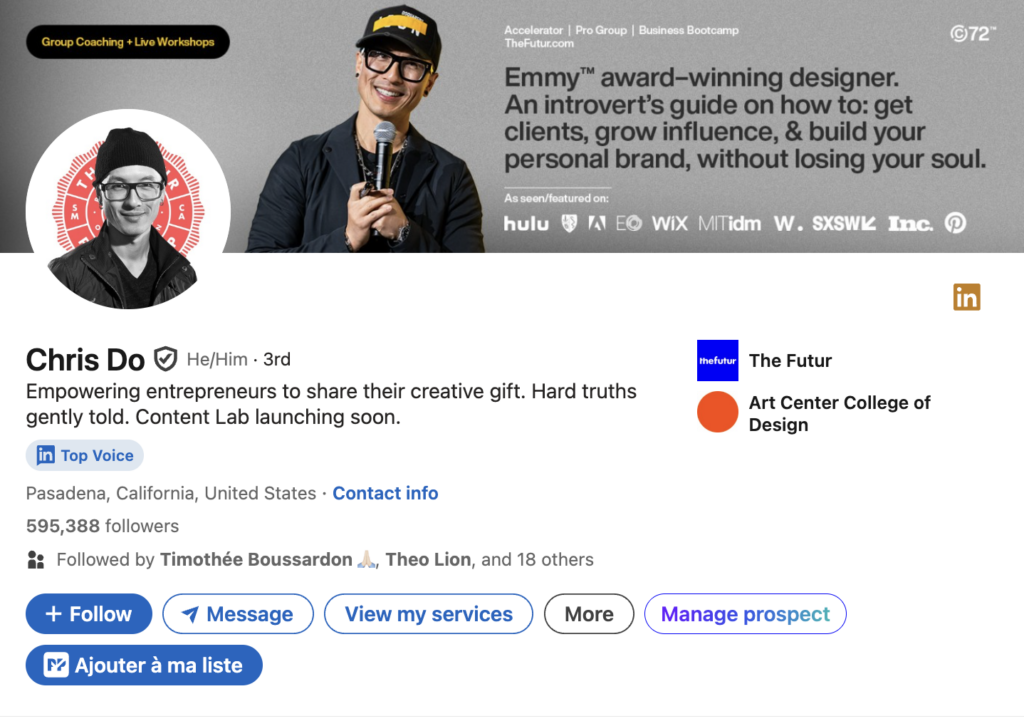
Improving this key indicator will also greatly improve your natural referencing on this social media platform. It’s a kind of SEO for LinkedIn.
LinkedIn SSI Score Criterion #2: Find the right people
This pillar assesses your ability to target and segment your network and engage your ideal audience. Too many people add just anyone, resulting in stagnant LinkedIn SSI score. 🤷🏻♀️
You need to ask yourself, who are the people who will add real value to your LinkedIn network?
Those who can become prospects, customers, candidates, partners, or ambassadors. Don’t accept or request just anyone, of course, but continue to develop your network intelligently and consistently: LinkedIn loves that. 🫶🏼
Many people send invitations to everyone in their network to reach the maximum number of connections.
Don’t do this: focus on adding relevant professionals, either those who are key players in your industry and whose posts you can follow for information, those you know personally, or your target audience.
So how do you do that? 🔍
- Use LinkedIn search or Sales Navigator search. Thanks to the features and filters, you can precisely target your ICP (sector, position, company size, country/city, hierarchical level, etc.).
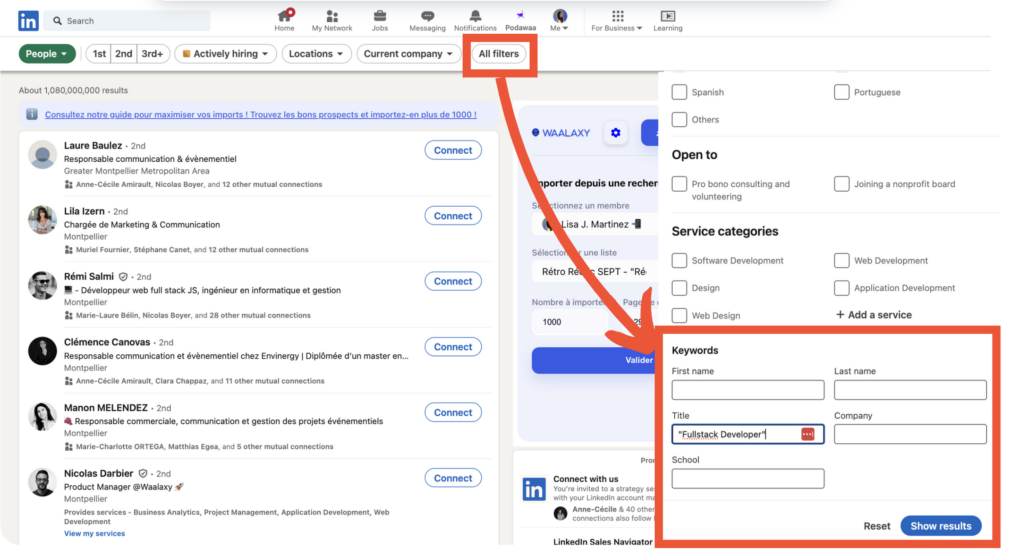
- Send connection requests and personalized automated messages to your targets to grow your network quickly and efficiently.
Each targeted connection will boost your SSI score. This quality of targeting will lead to a rapid increase in your score. 📈
To save time, you can use tools to automate your entire LinkedIn prospecting process: publish, target, import, segment, enrich, invite, contact… A large number of potential customers in no time.
With Waalaxy, for example:
– You create a campaign in which your target prospects are integrated into the CRM.
– You create your message.
– You launch your campaign to more than a thousand qualified people per campaign.
Then all you have to do is respond to interested parties, follow up, analyze the results, and repeat. It’s as easy as pie. 👋🏼
LinkedIn SSI Score Criterion #3: Exchange Information
This pillar measures your ability to post, comment, and engage. 💬
The algorithm rewards profiles that generate or fuel relevant interactions: this creates time spent on the platform and therefore value for LinkedIn (and for you).
The goal is therefore to determine whether you are truly participating in the conversation, whether you are a mere spectator or a real player 🎭, which helps the network gain interaction, content quality, and exchange.
Here are four ways to quickly improve this score:
1. Publish engaging content regularly. Even twice a week is enough to increase your reach, strengthen your legitimacy, and show the algorithm that you are active on LinkedIn (the important thing is consistency and the engagement rate under your posts, which also allows it to assess their relevance).
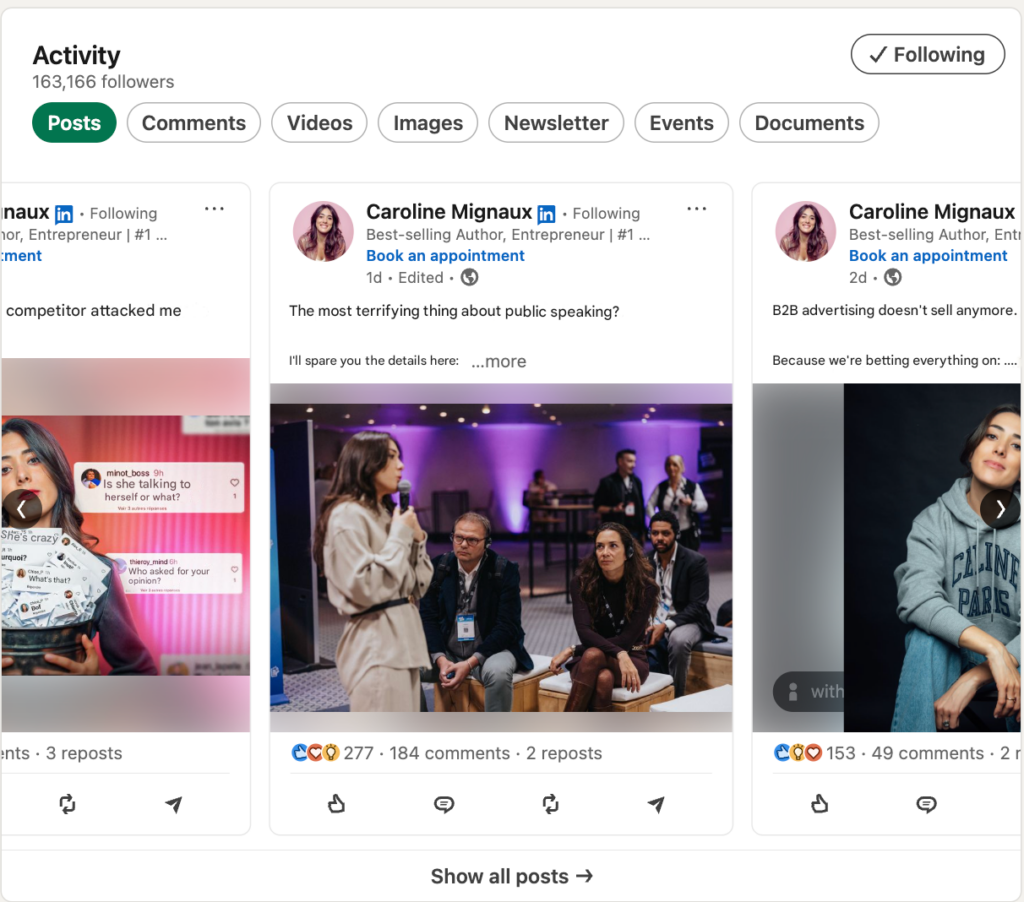
2. Share useful content (carousels, articles, videos, resources, case studies, industry insights, practical advice, feedback, etc.): each contextualized share shows that you are curious, informed, and capable of adding value.
3. Engage in a targeted manner in the feed (this point is often underestimated): making relevant comments on LinkedIn posts by your ICP, prospects, opinion leaders, or strategic companies brings you:
- Free visibility among their audiences,
- Inbound opportunities,
- Rapid SSI growth,
- And sometimes contacts who would never have seen your profile otherwise. 😊
4. Respond to comments and chat via private messages: a compliment on a post, a question, a personalized reaction… All these micro-interactions enrich your relationships on LinkedIn and boost your score.
So log in, post, comment, share, and discuss. The more qualified and qualitative your interactions on LinkedIn are, the higher SSI score will climb.
And if you see a post that inspires you? Like, comment, share, and/or send a message to the author. 🤗
LinkedIn SSI score criterion #4: Build lasting relationships
This pillar assesses the quality of your relationships (and it’s not just about volume).
LinkedIn analyzes the strength, depth, relevance, and continuity of exchanges: if you maintain your relationships, exchange private messages, get responses, engage in long-term dialogue… 🗣️ The more active the relationship, the more it is valued in the SSI.
Everyone knows how to add contacts on LinkedIn, but that’s no longer enough. Building a relationship is not just a matter of clicking on “Connect.”
You have to build truly solid relationships and nurture them. 🌱
- Send relevant LinkedIn messages: No aggressive sales pitches. LinkedIn favors natural conversations based on listening and mutual interest.
- Receive incoming messages on LinkedIn and respond to them quickly (your responsiveness influences your SSI).
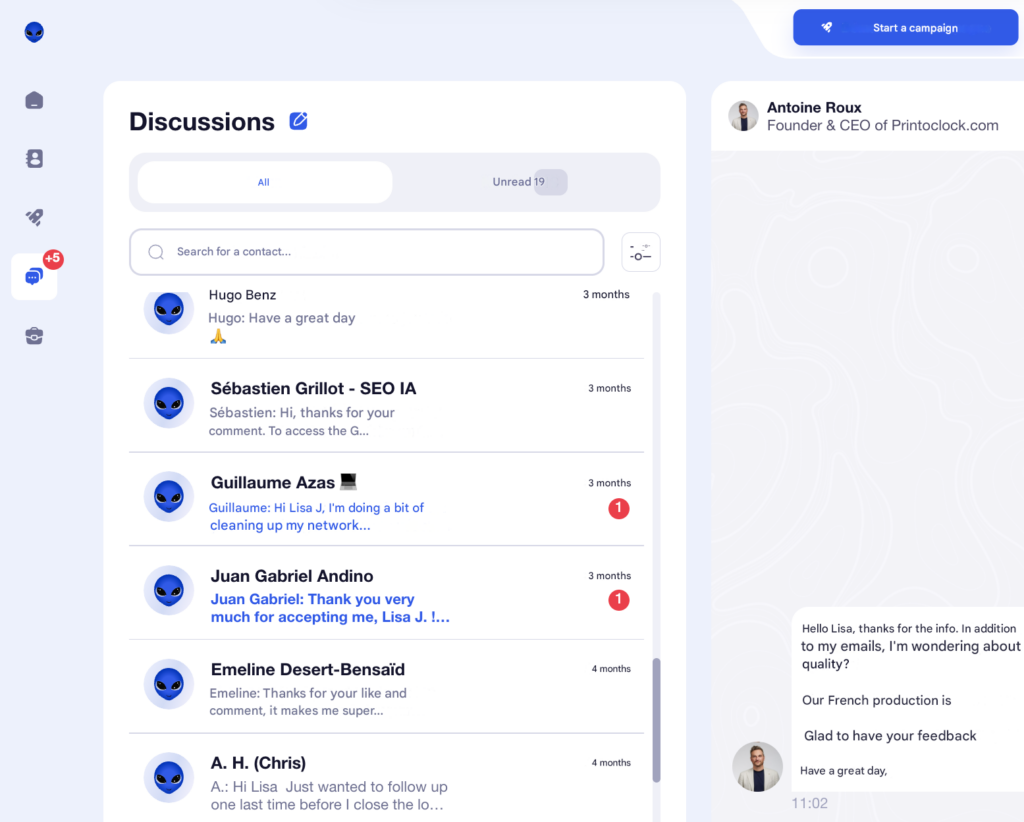
- Connect with decision-makers (managers, executives, leaders, etc.). LinkedIn awards more points to connections with high business potential, as they reflect strategic professional relationships. Some friendships are more valuable than others in the cutthroat world of business. 😂
- Develop lasting/trusting relationships and maintain them over time (continuity and long-term or recurring exchanges increase your SSI score).
When adding relationships, think about your brand image and don’t just focus on increasing the size of your network.
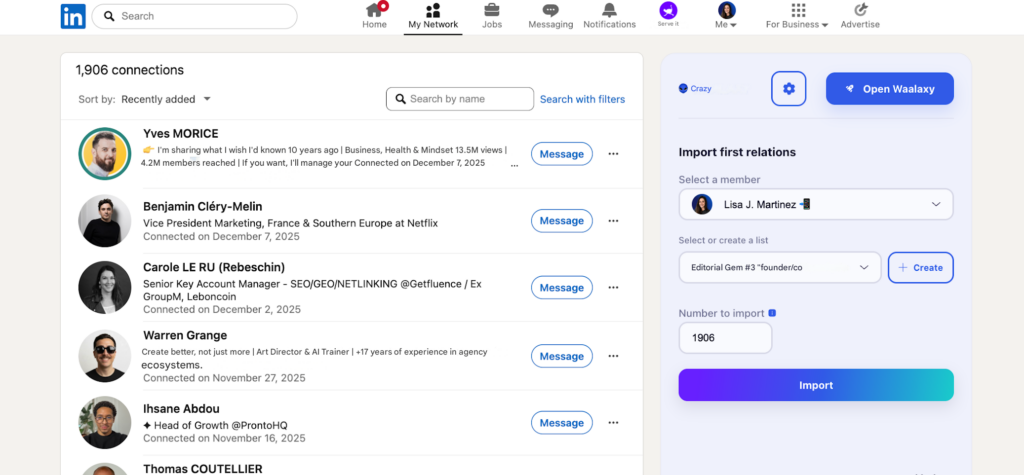
Target better, discuss more, respond quickly, maintain your connections, create contact, and add value. The SSI LinkedIn loves strong, ongoing relationships.
🎬 That’s it, we’ve just detailed the four pillars and ways to improve their scores. As we can see, even though they are distinct, they overlap.
The more you work on your LinkedIn SSI score, the easier it will be to reach your target audience and attract qualified LinkedIn users, thereby generating more leads (one way to achieve this is to automate your actions on LinkedIn 🤖).
How to use LinkedIn Automation to improve your LinkedIn SSI score?
Your LinkedIn SSI score evolves based on how regularly you post. But posting, engaging, segmenting, and sending messages—and doing everything manually—can quickly become time-consuming.
That’s where LinkedIn automation comes in handy. 🦾
Automate LinkedIn prospecting with Waalaxy
One of the most effective ways to improve your LinkedIn SSI score is to maintain regular activity: add prospects, send messages, follow up, etc.
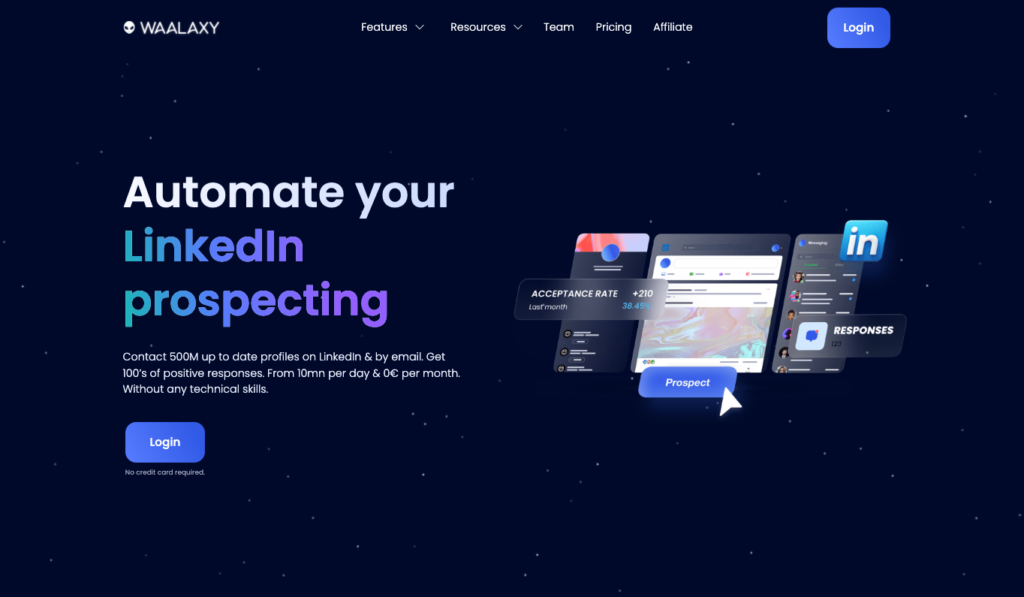
👽 This is precisely where Waalaxy becomes your best ally, allowing you to:
- Find, target, and segment your ICPs.
- Auto-import LinkedIn profiles from a profile, search, connections, posts, comments, groups, etc.
- Send automatic connection requests.
- Schedule personalized messages and follow-ups.
- Create multi-channel campaign sequences (LinkedIn + email).
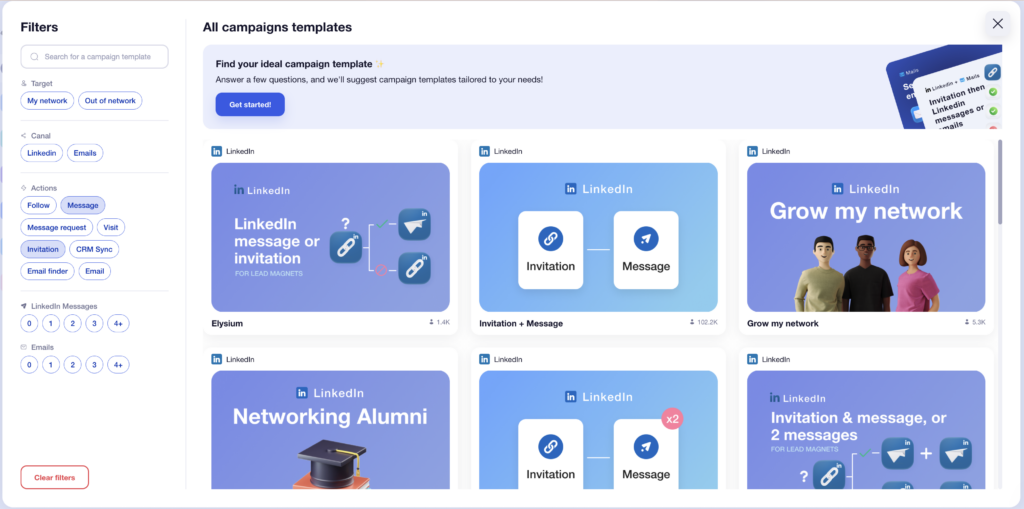
- Enrich your prospect lists with email addresses.
- Centralize all conversations with Waalaxy Inbox.
- Track performance via a dashboard (acceptance rate, response rate, conversions, etc.).
All without the risk of spam thanks to built-in smart limits. 🧠 Each action is triggered based on the prospect’s behavior (acceptance, no response, click, etc.).
With just a few minutes per week and thanks to Waalaxy, you can maintain regular activity, which is essential for boosting your LinkedIn SSI score (especially on the pillars “Find,” “Build,” and “Exchange”).
You can’t miss this. 👇🏼
Automate content creation with Kawaak
The third pillar of LinkedIn SSI score, “Exchange information,” relies heavily on your ability to publish regular, high-quality content. 💎
« » If you’re short on time or inspiration, Kawaak simplifies your life by automating the entire content production process. 🐰
- Generate high-value ideas and posts ready for publication.
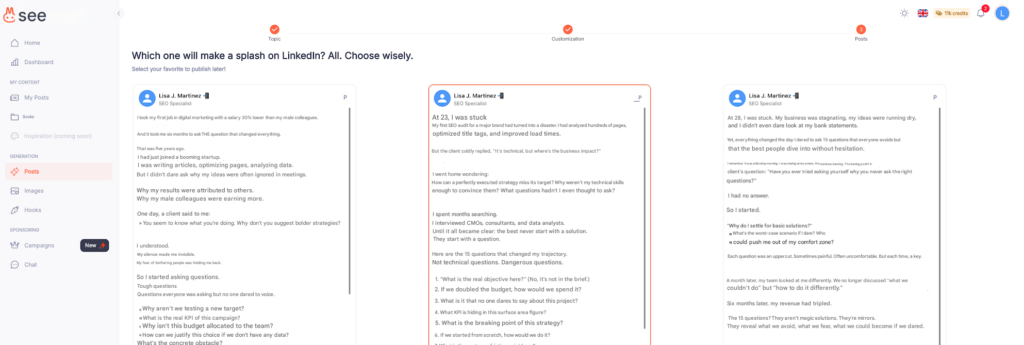
- Generate visuals tailored to your posts.
- Plan ahead to maintain a consistent presence without spending hours on it.
For example, you can import your rough ideas, let the tool structure your posts, and then schedule your entire editorial content plan in just a few minutes. 🪄 The result? Your profile stays active all the time—which the LinkedIn algorithm loves.
In short, Kawaak allows you to remain visible, engaging, and consistent: three essential levers for boosting your without daily social selling effort. 🤩
The tool also allows you to track your performance, identify the most engaging formats, and automatically generate comments under your connections’ posts directly in the LinkedIn feed thanks to the Chrome extension.

You can automate engagement under your posts by using engagement pods.
These encourage relevant and natural interactions (likes, contextualized comments), which sends a positive signal to LinkedIn: your content is useful → it deserves to be promoted → the performance of the post and your SSI automatically increase.
Case study: How to move from the top 41% to the top 2% of the LinkedIn SSI ranking in your industry?
How did I go from a LinkedIn SSI score of 30/100? 👇
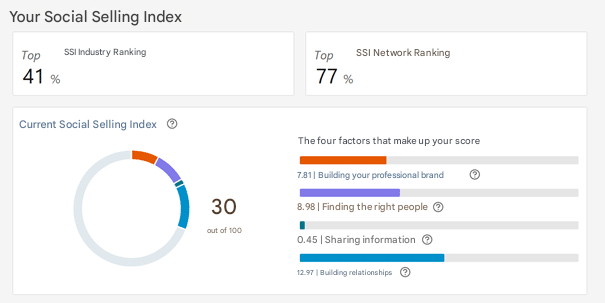
A has a LinkedIn SSI score of 70/100 in just 6 months. 👇
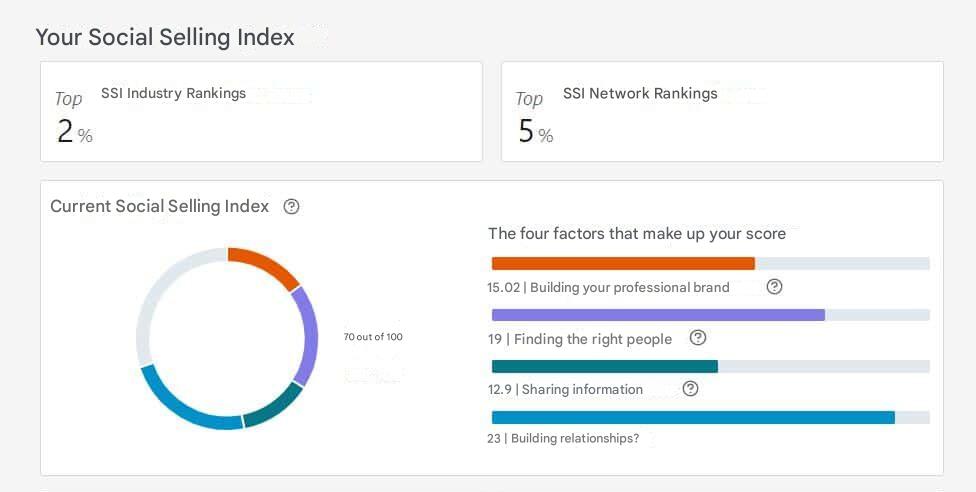
First, I identified my weaknesses. 😬
The first thing to improve was the pillar of exchange with other members of the network: commenting on their posts and sharing private messages with them.
- I used LinkedIn’s search function to target the right people.
- I used Waalaxy to automate my messages and automatically contacted a large number of people in my network. This also increased my score for establishing relationships. 😜
- I posted regularly using the TOFU-MOFU-BOFU strategy and got excellent results. It increased my LinkedIn SSI score for personal branding.
In 6 months, I built a personal brand on LinkedIn and managed to increase the reach of my posts by 100%. 😱
Before, a LinkedIn post from a team member could generate 50 reactions. But since LinkedIn has placed its trust in us, we have been posting regularly and developed a simple strategy… Posts quickly reach 500 reactions and hundreds of comments.

Conclusion: Impact of the LinkedIn Social Selling Index score
Social Selling Index LinkedIn is not a marketing gimmick: it is a strategic indicator that reveals the true quality of your LinkedIn presence. ✅
It is particularly useful in the early stages of the sales cycle:
- Build your personal brand.
- Expand your network,
- Publish relevant content,
- Be perceived as an expert.
- Generate inbound conversations.
If you track your SSI scores regularly, you can understand your performance, adjust your SMO strategy, optimize your content, refine your network, deliver better results, strengthen your credibility, build loyalty more easily, improve your visibility and your LinkedIn ROI… 👀
In short, the more you work on your SSI index, the more LinkedIn works for you, without having to prospect aggressively. Now you know everything! 🚀
Frequently Asked Questions (FAQ)
What is a good LinkedIn SSI score?
”A good LinkedIn SSI score“ depends on your industry, your business, and your goals…
But overall, a score of:
- 🔴 0–30: Low.
- 🟠 30–60: Fair. You could benefit from better engagement, a more qualified network, or more consistent activity on LinkedIn.
- 🟡 60–75: Very good SSI score.
- 🟢 +70/100: Excellent, this already places you among the most active and visible users in your industry (top 5%).
Passive users logically have a low SSI, as the algorithm detects no interactions, content, or network building. Conversely, a high SSI score indicates that you are perceived as an expert, that your profile inspires confidence, and that you generate more opportunities (visibility, prospects, conversations, invitations, etc.) by using LinkedIn as a real lever and growth accelerator, not just as an online resume. 🚀
Do I need a Sales Navigator LinkedIn account to view my LinkedIn SSI?
Good news: no, you don’t need Sales Navigator to view your LinkedIn Social Selling Index. 🤑 The SSI score is available free of charge to all users via a public URL provided by LinkedIn.
However, Sales Navigator can help you improve your social selling index on LinkedIn, as it allows you to:
- Identify qualified prospects more quickly.
- Target a very specific audience.
- Track your leads.
- Optimize your prospecting.
In short, SSI is free and accessible to everyone, but Sales Navigator can boost three out of four pillars (finding the right people, exchanging information, and building relationships).
From SSI to AI by Sales Navigator
LinkedIn recently introduced a new indicator: the AI SSI, available in Sales Navigator. 👀
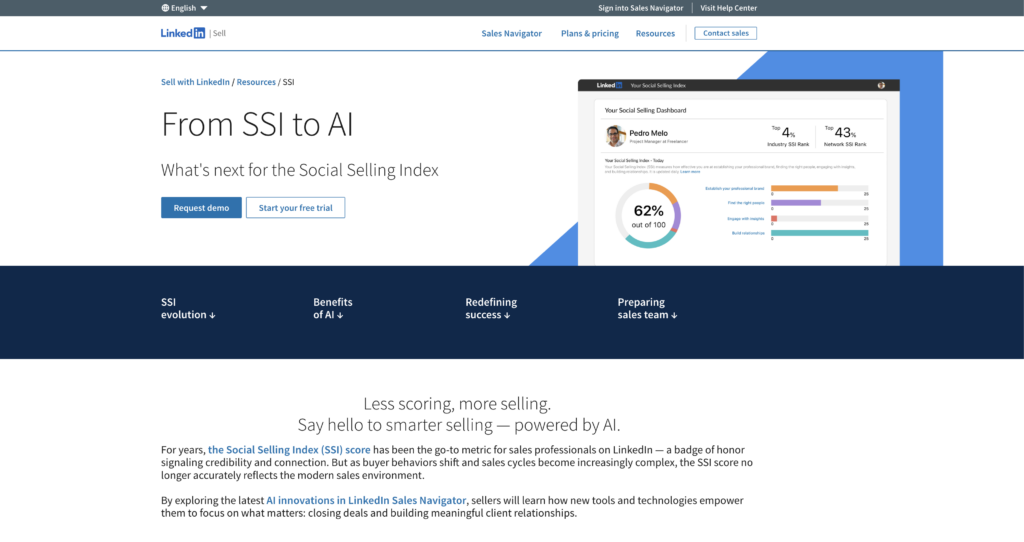
Unlike traditional SSI (available free of charge), this version uses artificial intelligence to analyze your business activity in a more detailed and contextual way. 🧠
AI makes it possible to identify high-impact actions, optimize targeting, and improve prospecting efficiency. It is an augmented version of SSI, designed to help you perform faster and smarter.
And there you have it, mission accomplished: you now know exactly how LinkedIn’s SSI works and how to get it off the ground. It’s up to you! 💥









